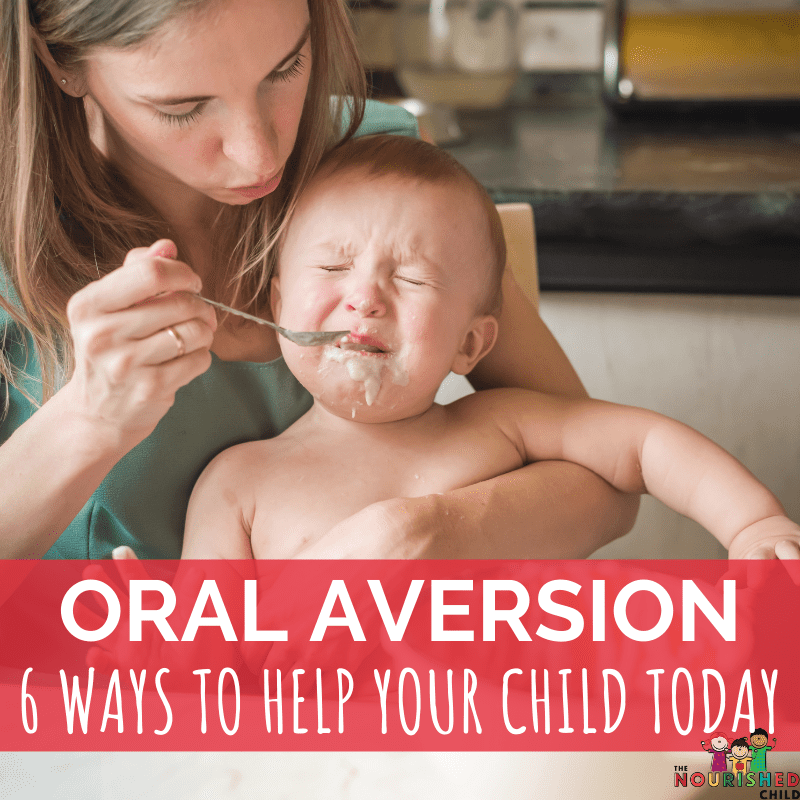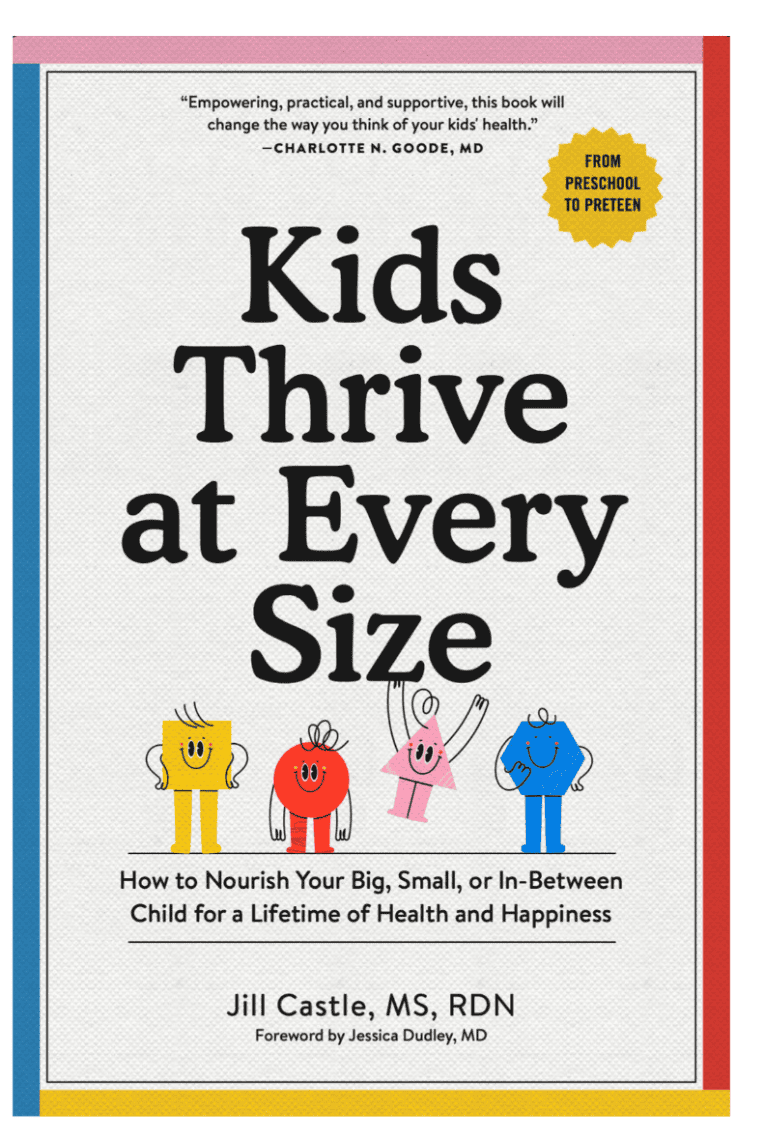Oral Aversion: 6 Ways to Help Your Child Today
May 20, 2022
Oral aversion in children might be upsetting to parents, but you can nourish your child through oral aversion with the right support. I’m here to guide you through it!
When a child refuses to eat, parents may feel powerless and worried.
Refusal to eat isn’t uncommon in children and may even be part of normal development. Most of the time, there’s nothing to worry about, and giving your child space to be autonomous is the best approach.

But oral aversion is a feeding disorder that can affect the growth and development of babies, young children, and children with developmental disabilities.
As a parent, you want nothing more than to know your child is well-nourished, cared for, and safe.
Don’t worry! I have a few tips to help you navigate the difficulty of nourishing a child through a feeding aversion.
But first, let’s dive into what you need to know about oral aversion and the signs and symptoms to look for in your child.
What is Oral Aversion?
It might surprise you to learn feeding difficulties affect 25%-35% of children and 40%–80% of children with developmental disabilities.
Oral aversion is when a healthy baby rejects food – either refusing to allow food to touch the mouth or refusing to eat it – even though he’s hungry. Kids with oral aversion are at risk of failure to thrive. Failure to thrive is when a child’s weight and development milestones fall behind other children of the same age and sex.
While feeding aversion can be seen in breast- and bottle-fed babies, it also occurs with older children, especially kids with autism or other developmental disabilities.
This isn’t “just picky eating’ and your child may need a little help to get enough nourishment.
Here’s how picky eating, extreme picky eating, and ARFID (Avoidant Restrictive Food Intake Disorder) differ from oral aversion.
- Picky eating – Picky eating might try your patience, but it rarely affects a child’s development. Young kids commonly go through food jags when they want to eat the same food day after day. And the fear of trying new foods (neophobia) is also common in young kids.
- Extreme picky eating – The anxiety level is higher for extremely picky eaters when presented with foods they refuse to eat. Because extreme picky eaters are more rigid around what they will and will not eat, kids may not get the calories and nutrition they need. This can also affect social and emotional well-being.
- ARFID – The DSM-5 classifies ARFID as an eating disorder. Kids with ARFID refuse to eat certain foods out of fear of choking or an aversion to the food’s sensory quality, such as certain textures. Kids with ARFID experience extreme fear and discomfort around food. Some kids require medical treatment to stabilize their weight.
What Causes Oral Aversion?
An aversion to food can happen when babies transition from breast to bottle, or when introducing new foods to young kids. Kids with autism spectrum disorder are more likely to have a feeding disorder than kids that do not have autism.
Here are a few reasons a child might develop an oral aversion:
- Motor – Kids may have difficulty chewing, swallowing, and holding food or utensils.
- Sensory – Many children have an aversion to certain foods’ textures, smells, or visual presentation.
- Fear – Kids may refuse to eat because they’re afraid of choking or not being able to swallow.
Also, babies born prematurely and who’ve received feedings through an IV or tube may be at extra risk for oral aversion simply due to lack of experience, or sensitization, of the mouth to stimulation.
Additionally, children who’ve had surgery or trauma to the mouth may be sensitive and fearful around the mouth.
Read: Eosinophilic Esophagitis (EoE) in Children
How Do I Know If My Child Has a Feeding Aversion?
When your young child refuses to eat, your first thought might be that he’s sick or teething.
If there’s no physical reason for your baby to refuse food, the signs and symptoms below may indicate a feeding aversion.
- Gagging
- Choking
- Turns away from the bottle or food
- Pushes food away
- Closes mouth
- Spits food out
- Shakes his head “no”
- Puts hands over mouth

How Can I Help My Child With Oral Aversion?
Oral aversion is not just picky eating. The wrong approach can even have lasting damage to your child’s relationship with food.
You may need to turn to experts specializing in children’s feeding disorders such as speech therapists, pediatric dietitians, and occupational feeding therapists to ensure your child gets the nutrition he needs.
There are a few strategies for treating oral aversions. Speech therapists may use food play and other techniques to minimize aversion while introducing various new foods and textures to your child.
But parents can help at home, too. A positive mealtime environment, including how parents offer and talk about food, plays the biggest role in a child’s feeding behaviors.
Here are a few tips to guide you while you help your child through an oral aversion.
Be Patient
It’s not easy when you can’t nourish a hungry child with the food he needs. Remember, oral aversion causes a lot of anxiety and discomfort for kids. Patience is the best tool in a parent’s toolbox.
Don’t Force Your Child to Eat
Force feeding and food pushing are never a good idea. As a mother, I understand you’re afraid your child isn’t getting enough food or formula. However, as a children’s nutrition expert, I know that force-feeding does more harm than good in the long run.
Don’t Blame Yourself
Sometimes a parent may feel like they did something wrong when their child doesn’t eat. Don’t blame yourself. Kids are individuals with their own food preferences and eating behaviors.
You can’t control how much a child eats. All you can do is provide healthy food in a positive mealtime environment.
Monitor Your Child’s Growth and Development
Weight loss or falling behind on the growth chart indicates your child isn’t getting enough food. If you’re worried your child has a feeding aversion, keep a close eye on his weight, physical and cognitive development.
Encourage Mouthing of Toys and Play with Food
Children who gnaw on teethers and put toys into their mouths are naturally desensitizing the oral area. Even brushing teeth, wiping the mouth after eating (don’t do this too much, though as it can contribute to aversion), and handling food, toys and other textures can help desensitize oral aversions.
Seek Help if You Need Support
A child refusing food can be very distressing for parents. Even if he gets the calories he needs, you can’t help but worry as a parent when your hungry child rejects food. You don’t have to do this alone, especially if you see your child is losing weight.
Ask your pediatrician for treatment options. Seek out specialists that can help you such as pediatric registered dietitians and speech therapists.

Send Me The Do’s & Dont’s of Picky Eating!
Final Thoughts About Oral Aversion
A kid’s refusal to eat is not always a cause for concern. As you’ve learned, there’s a spectrum of food refusal, from picky eating to oral aversion to ARFID.
You worry may about your little one getting enough calories and nutrients for healthy growth and development, but it’s important to remember your child is developing in other ways.
In young kids, refusal to eat and testing the boundaries of autonomy is a normal part of development.
But, when food causes extreme anxiety and discomfort, and impacts weight and development, it’s likely not a stage that will pass on its own.
With patience and support from healthcare professionals, you can nourish your child through an oral aversion.
If you need more support, my ARFID guide and nutrition for the extremely picky eater class, both indicated for ARFID in children, are helpful tools to ensure extremely picky eaters get the help they need.

Jill Castle, MS, RD
I like empowering parents to help their children and teens thrive at every size with realistic advice centered on healthful habits around food, feeding, nutrition and health behaviors. As a pediatric dietitian and author, my goal is to share strategies and realistic advice to help you raise a healthy and happy child through my articles and podcast.




